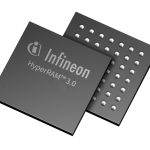It is suitable for applications requiring expansion RAM memory, including video buffering, factory automation, Artificial Intelligence of Things (AIoT) and automotive vehicle-to-everything (V2X), as well as applications requiring scratch-pad memory for intense mathematical calculations.
The device is a stand-alone PSRAM-based volatile memory that offers a simple and cost-optimized way to add extension memory. 
The data rates are equivalent to SDR DRAM but with much lower pin-count and lower power requirements.
The increased per-pin data throughput of the HyperBus interface makes it possible to use MCUs with fewer pins and PCBs with fewer layers. This provides opportunities for lower-complexity and thus cost-optimized designs to support target applications.
Infineon introduced the first generation of HYPERRAM devices supporting the HyperBus interface in 2017.
The second generation of HYPERRAM devices were introduced in 2021 and support both the Octal xSPI and HyperBus JEDEC-compliant interfaces with data rates of up to 400 MBps.
The third generation of HYPERRAM devices support the new extended HyperBus interface enabling 800 MBps data rates. HYPERRAM devices are available in density range of 64 Mb to 512 Mb. They are AEC-Q100 qualified and support industrial and automotive temperature grades up to 125°C.
The devices can be ordered now in a BGA-49 package. More information is available at www.infineon.com/HYPERRAM
